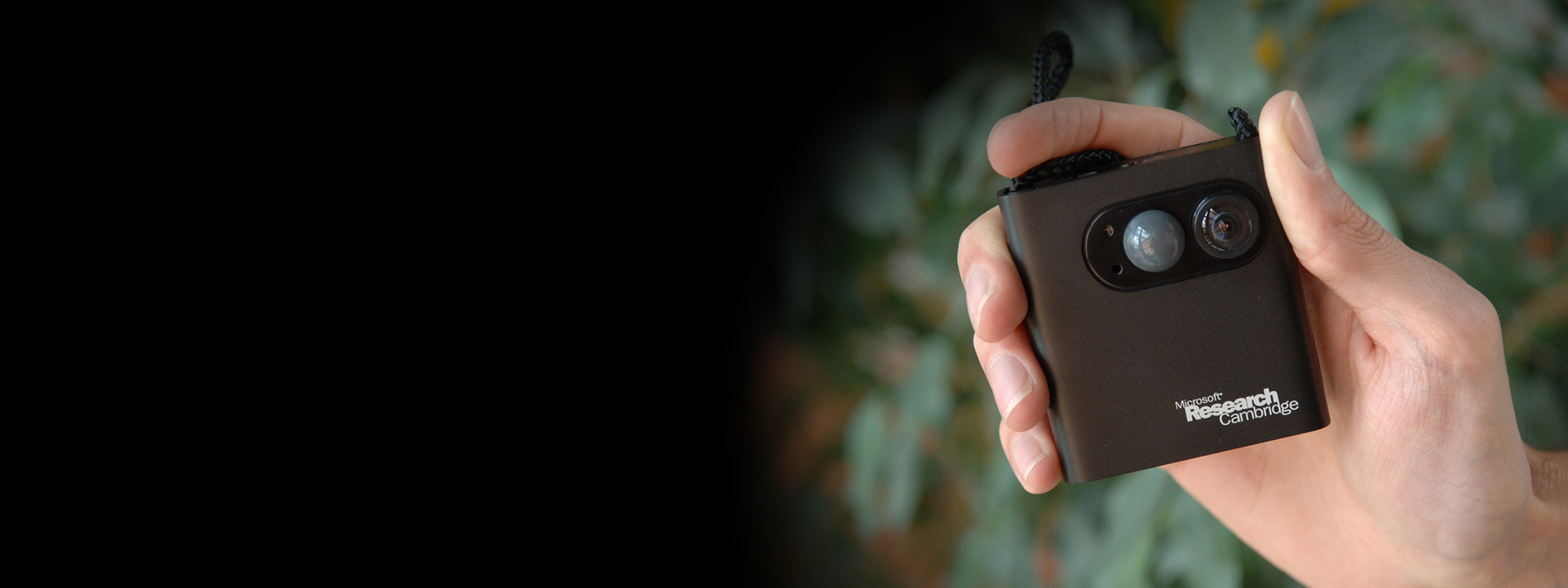Introduction to SenseCam
SenseCam is a wearable digital camera that is designed to take photographs passively, without user intervention, while it is being worn. Unlike a regular digital camera or a cameraphone, SenseCam does not have a viewfinder or a display that can be used to frame photos. Instead, it is fitted with a wide-angle (fish-eye) lens that maximizes its field-of-view. This ensures that nearly everything in the wearer’s view is captured by the camera, which is important because a regular wearable camera would likely produce many uninteresting images.
SenseCam also contains a number of different electronic sensors. These include light-intensity and light-color sensors, a passive infrared (body heat) detector, a temperature sensor, and a multiple-axis accelerometer. These sensors are monitored by the camera’s microprocessor, and certain changes in sensor readings can be used to automatically trigger a photograph to be taken.
For example, a significant change in light level, or the detection of body heat in front of the camera can cause the camera to take a picture. Alternatively, the user may elect to set SenseCam to operate on a timer, for example taking a picture every 30 seconds. We have also experimented with the incorporation of audio level detection, audio recording and GPS location sensing into SenseCam although these do not feature in the current hardware.
In our current design (v2.3), users typically wear the camera on a cord around their neck, although it would also be possible to clip it to pockets or belts, or to attach it directly to clothing. There are several advantages of using a neck-cord to wear the camera. First, it is reasonably stable when being worn, as it tends not to move around from left-to-right when the wearer is walking or sitting. Second, it is relatively comfortable to wear and easy to put on and take off. Third, when worn around the neck, SenseCam is reasonably close to the wearer’s eyeline and generates images taken from the wearer’s point of view – i.e., they get a ‘first person’ view. Informal observations suggest that this results in images that are more compelling when subsequently replayed.
SenseCam takes pictures at VGA resolution (640×480 pixels) and stores them as compressed .jpg files on internal flash memory. We currently fit 1Gb of flash memory, which can typically store over 30,000 images. Most users seem happy with the relatively low-resolution images, suggesting that the time-lapse, first-person-viewpoint sequences represent a useful media type that exists somewhere between still images and video. It also points to the fact that these are used as memory supports rather than rich media. Along with the images, SenseCam also stores a log file, which records other sensor data along with their timestamps. Additional user data, such as time-stamped GPS traces, may be used in conjunction with the SenseCam data via time-correlation.
Reviewing and Sharing SenseCam Images
The data recorded by the SenseCam can be downloaded onto a desktop or laptop computer, typically at the end of a day or week. Microsoft Research developed a simple viewer application (opens in new tab)that can be used to transfer the images in this way and then display them. The basis of the viewer, which is designed to be very straightforward to use, is a window in which images are displayed and a simple VCR-type control which allows an image sequence to be played slowly (around 2 images/second), quickly (around 10 images/second), re-wound and paused.
The fast-play option creates a kind of ‘flip-book’ movie effect – the entire event represented by the images is replayed as a time-compressed movie. Such rapid serial visual presentation (RSVP) techniques are well-studied in psychological literature1 and are particularly suited to SenseCam images. It is possible to delete individual images from the sequence if they are badly framed or of poor quality. An additional option is provided to correct for the ‘fish-eye’ lens effect using an algorithm, which applies an inverse model of the distortion.
It is also possible to import SenseCam image sequences into a more sophisticated application. MyLifeBits (opens in new tab) will allow the large number of images generated daily to be easily searched and accessed. Dublin City University have developed a sophisticated SenseCam image browser (opens in new tab) which assists in splitting sequences of images into different events by automatically analysing the images and sensor data generated by SenseCam.

